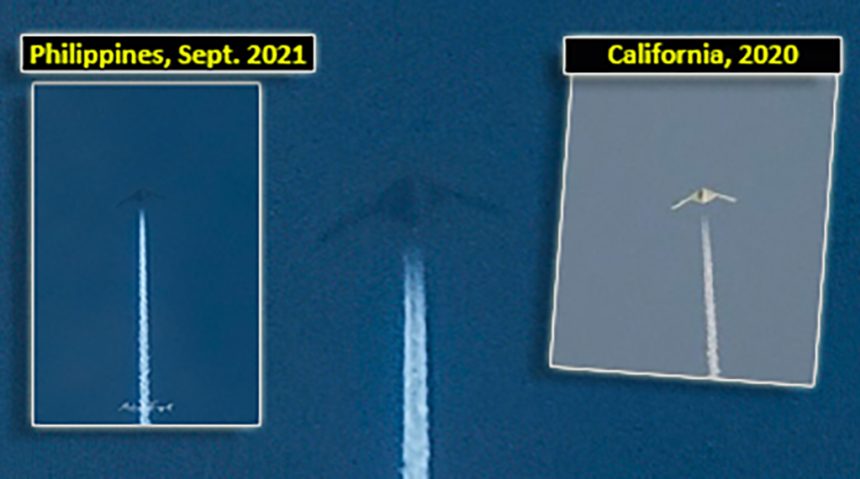Let’s talk about the mysterious flying wing aircraft that flew over the Philippines a few days ago.
On Sept. 2, 2021, at 06.15AM LT, Michael Fugnit took a photo of a rather mysterious aircraft at high altitude flying with a southwestern heading over the Philippines.
“I didn’t hear any sounds from the aircraft,” told us Michael in a message. “I was waiting for the sunrise since it is my daily routine to capture sunrise and sunsets when I took the photo from the top hill of Brgy. San Roque Municipality of Sta. Magdalena Province of Sorsogon”.
Analysis on the only photograph Michael took of the aircraft suggest that the image is genuine and not doctored.

The shot features what seems to be a large-span flying wing with straight trailing edge and trails two contrails, suggesting closely paired twin turbofan engines: in other words, the one photographed over the Philippines a few days ago appears to be strikingly similar to the mysterious UAS (Unmanned Aircraft System) spotted flying over Palmdale, California, in 2020, a UAS thought to be a either the highly classified Northrop Grumman RQ-180 drone, or a Lockheed Martin P-175 Polecat derivative.
This is what we wrote in November 2020, when the image of the UAS flying over California first appeared online:
The photo, which was claimed to be taken, “…in California just north of Edwards [AFB]”, shows an aircraft trailing two prominent contrails, suggesting the altitude of the aircraft at the time the photo was taken was in excess of approximately 25,000 ft. Contrails require moist, cold air to freeze the water vapor expelled during normal jet engine combustion. Considering the altitude of the aircraft at the time the photo was taken, the size of the aircraft in the photo may be significant. Published estimates of the wingspan of the RQ-180 drone claim it may be as large as 130 ft. Estimates of the wingspan of the Polecat suggest it is about 90 ft.
The U.S. Air Force does not acknowledge the existence of the RQ-180 drone, but a number of factors seem to support theories of its existence and even operational deployment. One theory that supports the operational deployment of the RQ-180 is the reduction in the number of RQ-4 Global Hawk reconnaissance drones. It’s possible a newer, more capable RQ-180 may have taken over missions previously assigned to RQ-4s.
Forbes magazine reporter David Axe is another keen-eyed journalist who recognized the significance of the new Kolinsky photo. Late Sunday night Axe wrote, “The Air Force reportedly tested the roughly 170-feet-wingspan RQ-180 at Groom Lake, part of the Area 51 complex in Nevada. By early 2020 the RQ-180 apparently was so well-established in Air Force service that the flying branch was comfortable cutting its fleet of non-stealthy RQ-4 Global Hawk drones.”
[…]
Observers of the photo on internet forums have made some interesting insights about the Kolinsky photo. Some suggest the planform of the aircraft in Kolinsky’s image is nearly identical to the Polecat. A revived P-175 (the original one crashed in 2007) or a testbed based on it? Maybe.
Provided they are the same type, the main difference between the sighting last year and the one of a few days ago is that the latter proves the mysterious (most probably unmanned) aircraft would be already conducting operational missions around the world. In fact, based on the location where the aircraft was spotted, it seems reasonable to believe it was returning from a mission in the South China Sea where there might have been interesting Chinese activity to surveil. Dispatching a HALE (High Altitude Long Endurance) low-observable drone from either the U.S. or a forward operating location (like Andersen Air Force Base, in Guam, that already hosts the RQ-4s) to cover some specific time-sensitive target, would totally make sense. These missions could require the aircraft to cross some unpopulated areas of the Philippines during daylight conditions (as happened on Sept. 2), when chances to be spotted from the ground are scarce.
Obioviously, there are many other intriguing theories, including the one that the aircraft overflying the Philippines could be a Chinese H-20 stealth bomber, but we have no details suggesting the Chinese have reached a phase of the development of their aircraft that would allow them to fly it in daylight inside enemy airspace.
Dealing with the RQ-180, the existence of a secret unmanned aerial system (UAS), designed for intelligence, surveillance and reconnaissance (ISR) missions, and scheduled to be operational with the U.S. Air Force by 2015 was first revealed by Aviation Week & Space Technology, Senior Pentagon Editor Amy Butler and Senior International Defense Editor Bill Sweetman in December 2013.
Developed by Northrop Grumman since 2008-2009, the stealthy RQ-180 is designed to operate in “contested” or “denied” airspace, as opposed to the non-stealthy RQ-4 Global Hawk that are intended for “permissive” scenarios.
In their analysis back then, Sweetman and Butler said: “It is similar in size and endurance to the Global Hawk, which weighs 32,250 lb. and can stay on station for 24 hr. 1,200 nm from its base. The much smaller RQ-170 is limited to 5-6 hr. of operation. […] The aircraft uses a version of Northrop’s stealthy “cranked-kite” design, as does the X-47B, with a highly swept centerbody and long, slender outer wings. Northrop Grumman engineers publicly claimed (before the launch of the classified program) that the cranked-kite is scalable and adaptable, in contrast to the B-2’s shape, which has an unbroken leading edge. The RQ-180’s centerbody length and volume can be greater relative to the vehicle’s size.”
The RQ-180 is nicknamed the “Great White Bat” or sometimes “Shikaka”, a fictional sacred white bat from the 1995 movie Ace Venture 2, AW&ST reported.
A big thank you to Michael Fugit for allowing us to use his photograph and to our reader Marls for the heads up!









